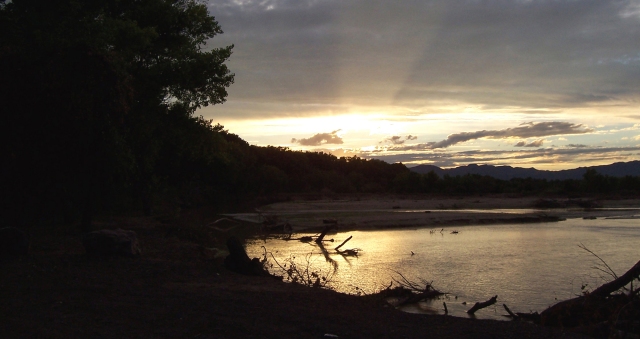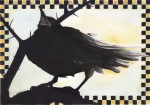
Rio Grande at Sunset, Socorro, New Mexico
Several years ago, Duane Baker and I went cat fishing down on the Rio Grande here in Socorro. It was the 1st week of April and the river was running good. We got there just about dusk, pulled out the sunflower seeds, Doritos, and Dr. Peppers, leaned back and listened to the water swirling, sloshing, and gurgling. We managed to catch several 12 to 16 inch fish, when somewhere after midnight Duane got a very hard hit. He started reeling it in when the line went suddenly slack. After reeling the line all the way in, out of the dark water came the front 12 inches of what must have been a 2 to 3 foot cat fish. The back part of the fish had been bitten cleanly off.
That was a bit unnerving. After our “What the……?” Duane says, “Hey, I’ve got an idea. You know that rattlesnake we killed when we got here? I’ve got some wire leader for tiger muskies, let’s hook that snake up and see what happens.”
So we did, and we cast that 42 inch rattler out in the same area we had been fishing, sat back and worked on finishing off the sunflower seeds, watching the bats skim the river, and catching a few shooting stars as the water rippled on downstream. Somewhere along about 2:30 am, it happened. We got that monster hit, but like before, it went slack. This time there wasn’t even a drag on the line. On reeling it in, we found that the wire leader had been cut as cleanly as if it had been cut with wire cutters, with absolutely no sign of our rattlesnake bait. As before, this was unsettling, to say the least, but the sunflower seeds were pretty much gone, so we packed it up and went home.
About 3 weeks later, I was talking to an older gentleman (since deceased) who had grown up in Socorro, from one of Socorro’s oldest families, and telling him about our fishing trip.
“Tiburón” he said, “You know, tiburón de barro, the Rio Grande mud shark!”,
to which my response was “huh?’
“Well, before they built the dams, they came up the river all the time. My grandpa who grew up in San Marcial said they got caught behind the dam and that they are still there. When the river goes dry, they wiggle down into the mud until the water comes up. We were always told to be careful when we were hanging around the water. They don’t get, like shark big. They only get 4 to 5 feet long. Like catfish, they don’t got scales, but they got really sharp teeth….”
“My great grandpa, he worked on building that first dam down there at Elephant Butte. He’d go down there and live in tents while they were working. That was, … I dunno, 1910 maybe. They didn’t have time to do no fishing, but he sure knew about tiburón.”
So there you go, Carcharias Rio Grandii, the Rio Grande mud shark.
The documentation on it is really quite slim. It’s primary habitat was mostly destroyed a hundred years ago before people cared about such things. The sightings are all anecdotal, made by fishermen who are prone to drinking cheap beer, so there’s not really much to go on, and we did not actually see the creature.
























